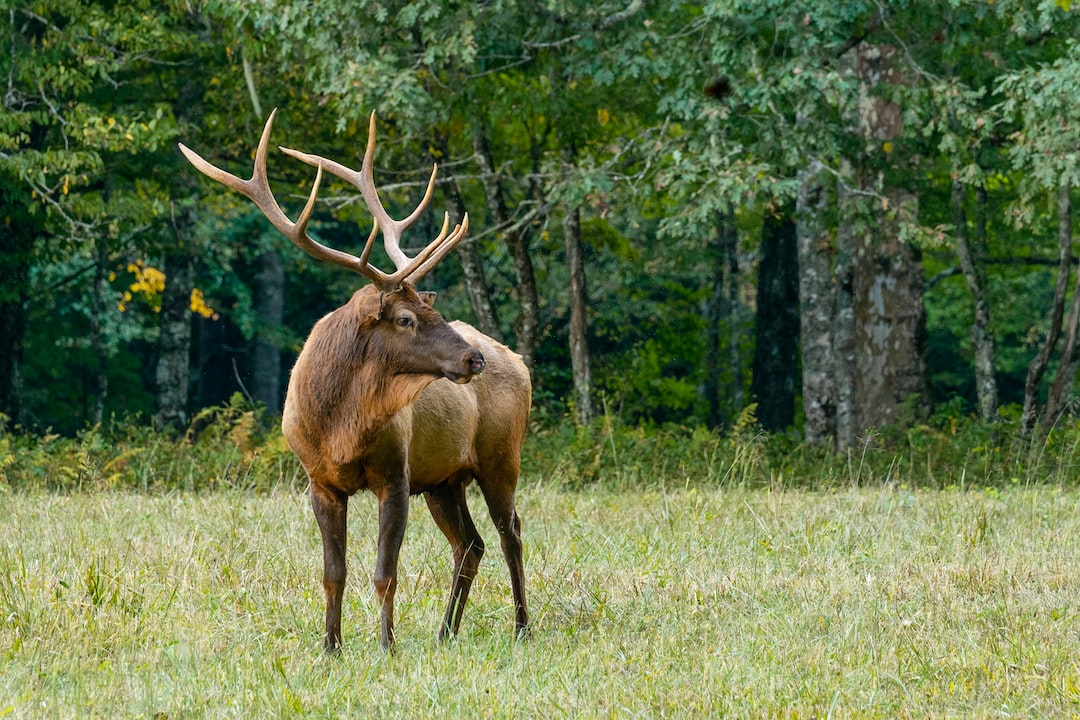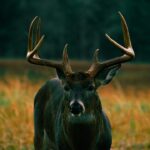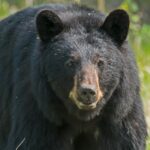If you’re looking for the best elk hunting tips to help you get that trophy bull this season, then look no further.
From understanding elk behavior and sounds to finding good elk country and pre-rut strategies, we’ve got all the advice and knowledge you need. Learn how to call in a herd of bulls with confidence or identify prime spots during the rut period – it’s time to take your hunt up a notch.
Identifying Good Elk Country
When it comes to identifying good elk country, the location and terrain of an area are key factors. Seek out spots with broad glades or clearings that offer abundant nourishment sources such as grasses, bushes, and trees.
You’ll also want to look for water sources nearby like streams or ponds. The terrain should be varied enough so that you can find cover in the form of thick brush or forested areas.
When scouting for elk sign, pay attention to tracks, droppings, rubs on trees from antlers, wallows used by bulls during mating season (the rut), and other signs that indicate a presence of elk in the area.
With these tips in mind, you will be able to better identify good elk country. Wind direction should be taken into account when setting up your stand; it is important to make sure you are downwind from any potential targets so they won’t catch your scent before you have a chance at getting off a shot.
Additionally, roads and trails leading into the area should be monitored closely as this is often how hunters get access into remote spots but can also lead other people into your hunting ground.
Lastly, take note of natural obstacles like creeks or ravines which could serve as barriers between you and animals making them less likely to cross over while traveling through their territory looking for food or mates during mating season (the rut).
Identifying prime elk habitat is an essential element for a successful hunt, and with the correct information and planning you can enhance your odds of success. With that in mind, let’s move on to calling in Elk; a skill that requires finesse and patience.
Calling in Elk
Calling in elk is a key part of hunting success. Knowing the different types of calls and when to use them, as well as tips for successful calling and common mistakes to avoid can be critical factors in bagging your trophy bull.
Various strategies exist for calling elk, including grunting and mewing. Grunting or “mewing” is one of the most popular methods used by hunters to attract elk. This involves making a series of low-pitched sounds that mimic those made by bulls during mating season (rut).
Cow calls are also effective for attracting bulls; these consist of higher pitched noises that sound like cows looking for mates. Bugling is another popular method used during rut, where hunters imitate the loud bugles produced by bulls while searching for females or defending their harems from other males.
To ensure success when calling in elk, there are certain tips you should keep in mind. Start with short bursts rather than long sequences – this will give nearby animals enough time to respond before moving on. Be sure not to overcall either; if you call too often or too loudly you may scare away potential targets instead of luring them closer.
Additionally, consider using scents and decoys along with your calls – these can help draw attention from even further distances away than just vocalizations alone would do so.
Lastly, there are some missteps that hunters can make while attempting to lure elk which should be prevented. One such mistake is getting too close – remember that elk have excellent hearing so approaching an animal within range could easily spook it away before you ever get a chance at taking aim.
Additionally, don’t stick with one type of call – try switching up between grunting/mewing and cow/bugle calls every few minutes as this will help increase your chances significantly since different animals may respond better depending on what kind they hear first.
Calling in Elk is an important skill for any successful elk hunter to master, and understanding the different types of vocalizations and behavior that elk exhibit can be key to a successful hunt. With this knowledge, hunters will be better equipped to respond appropriately when they hear these sounds on their next hunting trip.
Understanding Elk Sounds and Behavior
Elk vocalizations are an important part of understanding elk behavior and successful hunting. Elk make a variety of sounds, from bugles to cow calls, and each sound has its own purpose and meaning. Interpreting elk vocalizations can be advantageous for hunters, allowing them to comprehend the behavior of these animals and better their odds in hunting.
Elk possess a range of vocalizations they employ to communicate, ranging from loud bugles used by bulls in the rutting season to lower-pitched mews utilized by cows when connecting with their young or seeking out a bull’s attention during mating.
Bugles are loud, high-pitched cries used by bulls during the rutting season to announce their presence or challenge other males in the area.
Cow calls are softer, lower-pitched mews used by cows to communicate with calves or attract a bull’s attention during mating season. Other common elk sounds include snorts, grunts, chirps, whistles, bawls and bleats.
Interpreting elk vocalizations can give hunters an invaluable insight into what is happening in the area. A loud bugle indicates a dominant bull may be trying to establish dominance over his harem, whereas cow calls suggest females are either looking for mates or tending to young calves.
By deciphering these distinct sounds, it becomes easier to determine when it’s best to stay concealed or move closer for a better chance at game animals like deer and moose; as well as knowing when one can safely approach an animal without fear of being attacked during breeding season.
It is important to understand the different types of vocalizations and behaviors that elk exhibit in order to successfully hunt them. With proper pre-rut strategies, you can increase your chances of finding and attracting bulls during this period.
Pre Rut Strategies for Hunting Elk
The pre-rut period is an exciting time for hunters as the elk are just beginning to move and become active. Identifying the best time for hunting during this period can be tricky, but with some knowledge of elk behavior, it’s possible to increase your chances of success.
The key is understanding when bulls are most likely to be on their feet and actively searching for cows.
In general, you should plan your hunt during the weeks leading up to peak rut activity in your area. During this time, bulls will start moving around more frequently in search of receptive cows and establish dominance over other males by bugling or sparring with them.
This makes them easier targets than they would be later in the season when they may have already found a harem or are exhausted from fighting off other suitors.
Using scents and decoys effectively during this period can also help attract bulls who might otherwise remain hidden away until later in the season. Bulls will often investigate anything that smells like a cow or another bull out of curiosity or aggression; using scent lures such as estrus urine can draw these animals out into open areas where they’re easier to spot and target safely without disturbing nearby herds.
Decoys work similarly by simulating an animal that could potentially pose a threat – again drawing curious (or aggressive) bulls out into viewable range while still keeping them at a safe distance from any real danger posed by humans hunting nearby.
By understanding the best time to hunt during the pre rut period, using scents and decoys effectively, and tips for finding and attracting bulls during this period can help increase your success rate when hunting elk.
Moving on from pre-rut strategies, let’s look at some strategies that are useful for hunting during both the rut and post-rut periods.
Strategies for Hunting During the Rut and Post Rut Periods
The rut and post-rut periods are some of the best times for hunting elk. Knowing when to hunt during these periods is key, as well as understanding how to use scents, decoys, and calls effectively in order to attract bulls. With some research and preparation, one can boost their likelihood of success during this period.
During the rut period, which typically spans mid-September to late October, and post-rut season from November through early December, elk become more active due to mating season making them ideal targets for hunters.
This is when elk become more active due to mating season which makes them easier targets for hunters. Before heading out, scouting can be useful in order to ascertain where the elk are most likely situated and devise a plan accordingly.
Using Scents, Decoys, and Calls Effectively During These Times:
Using scents like urine or tarsal glands will help lure in bulls who are looking for mates by simulating an estrus cow call. Placing decoys strategically throughout your hunting area can also be beneficial as it gives off visual cues that could attract passing bulls who may be looking for a mate or defending their territory against other males.
Lastly, calling techniques such as bugling or cow calling should be used sparingly but with precision since too much noise could scare away potential targets instead of drawing them closer towards you.
Patience is essential when it comes to finding and attracting bulls during these times as they won’t always respond right away, if at all. Try scouting different areas each day until you find one that has signs of recent activity such as tracks or droppings; then set up shop there.
Remember to take into account wind direction – having a crosswind blowing towards where you expect elk will give them better chance at picking up on any scent trails coming from your location.
Lastly, don’t forget about food sources – make sure there’s plenty nearby so that hungry bull isn’t scared off by his growling stomach before he even gets close enough for a shot.
FAQs in Relation to Elk Hunting Tips
What are the basics of elk hunting?
Elk hunting is a widely-enjoyed activity in the western US, requiring an understanding of elk habits and habitat as well as safety measures. It requires knowledge of elk behavior, terrain, and safety precautions.
To hunt an elk successfully, one must know how to identify them by their size and antlers; be familiar with the habitat they prefer; understand when and where to look for them; have proper equipment such as firearms or bows and arrows; practice shooting skills regularly; learn how to field dress an animal properly if successful in harvesting one; obtain all necessary licenses/permits before heading out into the woods.
Elk hunting can be a rewarding experience but also very challenging so it’s important that hunters are well-prepared before embarking on this type of adventure.
What is the best way to prepare for an elk hunt?
Preparing for an elk hunt requires a comprehensive approach. Investigate the region and climate of your elk hunt spot beforehand so you know what type of equipment to take. Next, ensure that all necessary licenses and permits are obtained prior to arriving at the hunting site.
Additionally, practice shooting regularly so that when it comes time to take aim on game day, you can do so accurately and confidently. Ensure that you have the necessary provisions to sustain yourself and any other hunters with whom you may be travelling.
With these steps taken care of ahead of time, success is much more likely during an elk hunt.
What is the success rate of elk hunting?
The success rate of elk hunting varies greatly depending on the region, season, and hunter’s experience level. Generally speaking, hunters in areas with a healthy population of elk can expect to have a successful hunt approximately 10-20% of the time.
Hunters who are less experienced or those hunting in regions where elk populations are low may have lower success rates than this average. Before hunting, it is vital for a successful outing to research the most effective techniques of scouting and tracking.
What time of day is best to hunt elk?
The best time of day to hunt elk depends on the season and location. In general, it is recommended to begin hunting just before sunrise when elk are most active. During summer months, early morning hours provide the coolest temperatures which can help reduce human scent that may spook animals away from your area.
As evening approaches, elk will become more active as they search for food and water sources during cooler temperatures. Late afternoon or dusk is often an ideal time for hunters in many locations due to increased visibility at this hour.
However, it is important to research the local hunting regulations and best practices for your specific area.
Conclusion
To conclude, elk hunting is a rewarding and challenging activity. With the right preparation and knowledge of elk behavior, you can increase your chances for success in finding and harvesting an animal.
By learning how to identify good elk country, understanding the different sounds they make, calling them in correctly and utilizing strategies that work during pre-rut periods as well as during rutting seasons post-rut will help you find success on your next hunt.
Utilizing these tips for successful Elk Hunting will give any hunter an edge over their competition.



